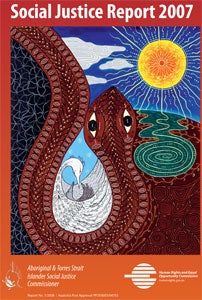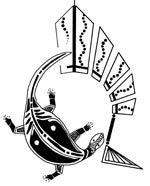Social Justice Report 2007: About the Report & Credits
Social Justice Report 2007
About the Report & Credits
ISSN 1321-1129
Cover Design and Desktop Publishing by Jo Clark
Printed by Paragon Australasia Group
The Aboriginal and Torres Strait Islander Social Justice Commissioner acknowledges the work of Human Rights and Equal Opportunity Commission staff and consultants in producing this report (Fabienne Balsamo, Somali Cerise, Kirsten Cheatham, Anna Dawson, Darren Dick, Janet Drummond, Cassandra Goldie, Christopher Holland, Vanessa Jackson, Christina Kenny, Julia Mansour and Emilie Priday).
Artist Acknowledgement
Art work reproduced on the cover by Associate Professor Helen Milroy, 'Restoring Life and Spirits: Recovery from Trauma'. Thank you to Helen Milroy for granting us permission to use her art work.
Copyright © Helen Milroy
About the Artwork: Restoring life and spirit: recovery from trauma

Note by the artist, Helen Milroy
We are part of the dreaming. We have been in the dreaming for a long time before we are born on this earth and we will return to this vast landscape at the end of our days. It provides for us during our time on earth, a place to heal, to restore purpose and hope, and continue our destiny.
Our country and people have suffered many traumas since colonisation, the magnitude of which is beyond words. Looking through trauma is like being trapped in the back of a mirror, there is no reflection of self. It is like being trapped in darkness, unable to see where to go or what is there, surrounded by ‘not knowing’, paralysed by fear.
When we are wounded, our story is disrupted and life becomes fragmented. We may not be able to find our way forward and may start to see life through warped mirrors. We have to understand that trauma is only a part of our story and our story is part of a much greater story that has a different beginning, is enduring and will continue well beyond our lifetime.
To have integrity of existence we need to have an integrated experience throughout so that we do not isolate pockets of our life, disconnected from present reality, and so that we do not live in two worlds but can maintain an essence of continuity throughout our existence on this earth. We cannot play parts without understanding the whole story of Australia.
Part of the problem in healing is being able to put all the parts together again as there are still too many of us missing. To survive as peoples distinct in culture, we have to restore the collective. The individual may not be able to carry the survival of the culture into eternity but the collective can.
We can return to the dreaming to heal, to rest for a while and have our spirit restored, to find our place on the serpent and recover our purpose in this life. We have to trust that we will be cared for until we can walk again, taking sustenance from the tree of life that has sustained us over generations. Our ancestors watch and wait patiently for our return. They are like the clouds that roll through the sky coming to greet us and shed tears for our wounds, holding us within a teardrop, soothed and bathed in this healing water.
Then a new day will dawn and our ancestral guides will once again set us on our journey through life. To recover, we have to allow the sun to shed light and warmth on dark places and assist our wounds to heal. We have to shatter these warped mirrors and find our true reflection of self, spirit and country. We have to stand together, united and proud.
We may not always have control over what happens to us in life, but we do have control over truth. The ultimate control we have is the coherence and continuity of our own story.
To live without spirit is to sleep without dreams and wake to oblivion.
About the Social Justice Commissioner's logo

The right section of the design is a contemporary view of traditional Dari of head-dress suggests the visionary aspect of the Aboriginal and Torres Strait Islander Social Justice Commission. The dots placed in the Dari represent a brighter outlook for the future provided by the Commission's visions, black representing people, green representing islands and blue representing the seas surrounding the islands. The Goanna is a general symbol of the Aboriginal people.
The combination of these two symbols represents the coming together of two distinct cultures through the Aboriginal and Torres Strait Islander Commission and the support, strength and unity which it can provide through the pursuit of Social Justice and Human Rights. It also represents an outlook for the future of Aboriginal and Torres Strait Islander Social Justice expressing the hope and expectation that one day we will be treated with full respect and understanding.
© Leigh Harris
